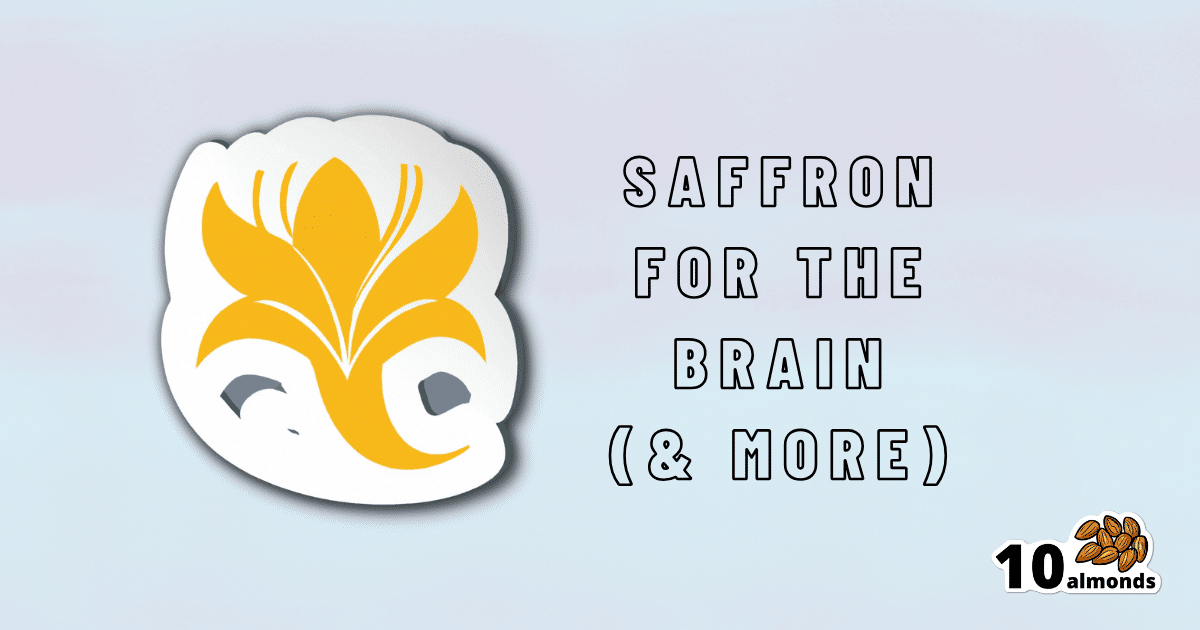Saffron For The Brain (& More)
Sailuotong, a herbal medicine containing ginseng, ginkgo biloba, and saffron, has been found effective for brain health in older people. Learn more about its benefits and where to find it.

Saffron For The Brain (& More)
In yesterday’s edition of 10almonds, one of the items in the “health news from around the world” section was:
Clinical trial finds herbal medicine Sailuotong effective for brain health in older people
But, what is it?
❝SaiLuoTong (SLT) is a modern compound Chinese herbal medicine preparation in capsule form containing standardized extracts of Panax ginseng, Ginkgo biloba, and Crocus sativus L❞
We’ve written previously about ginseng and ginkgo biloba:
So, what’s this about Crocus sativus L.?
That is the plant better known as saffron. And, for all its wide availability (your local supermarket probably has at least a tiny amount in the spice section), there’s a reason we don’t see much of it:
❝Saffron blooms only once a year and should be collected within a very short duration. It is picked during 3–4 weeks in October-November. The method for the cultivation of saffron contributes greatly to its high price. According to some reports, this species is a sterile triploid and so does not produce fertile seeds. Germination can take 1–6 months at 18°C. It takes 3 years for plants to flower from seed.❞
Source: Crocus sativus L.: A comprehensive review
That’s fascinating, but what does it do for us?
Well, in the words of El Midaoui et al. (2022):
❝In the frame of a double-blind-placebo-controlled study, 30 mg per day supplementation with saffron for 16 weeks resulted in improved cognitive function in patients suffering from mild to moderate Alzheimer’s disease.
Moreover, the follow-up of this study in which the authors evaluated the effects of saffron (30 mg/day) for 22 weeks showed that saffron was as effective as donepezil in the treatment of mild-to-moderate Alzheimer’s disease❞
Read the full review: Saffron (Crocus sativus L.): A Source of Nutrients for Health and for the Treatment of Neuropsychiatric and Age-Related Diseases
Not just that, but it also has powerful antioxidant and anti-inflammatory properties beyond the brain (though the brain is where research has been most focused, due to its neuroprotective effects).
(this, too, is a full research review in its own right; we’re getting a lot of “bang for buck” on papers today)
And more?
Yes, and more. Lots more. To bullet-pointify even just the abstract from another research review:
- Saffron has been suggested to be effective in the treatment of a wide range of disorders including coronary artery diseases, hypertension, stomach disorders, dysmenorrhea and learning and memory impairments.
- In addition, different studies have indicated that saffron has anti-inflammatory, anti-atherosclerotic, antigenotoxic and cytotoxic activities. (This is all good; the cytotoxic activities are about killing cancer cells)
- Antitussive effects of stigmas and petals of C. sativus and its components, safranal and crocin have also been demonstrated.
- The anticonvulsant and anti-Alzheimer properties of saffron extract were shown in human and animal studies.
- The efficacy of C. sativus in the treatment of mild to moderate depression was also reported in clinical trial.
- Administration of C. sativus and its constituents increased glutamate and dopamine levels in the brain in a dose-dependent manner.
- It also interacts with the opioid system to reduce withdrawal syndrome.
- C. sativus and its components can be considered as promising agents in the treatment of nervous system disorders.
For more details on any of those items, see:
The effects of Crocus sativus (saffron) and its constituents on nervous system: a review
Is it safe?
The effective dose is 30mg/kg and the LD50 is more than 20g/kg, so yes, it’s very safe. Given the price of it, this also means that if you’re the size of this writer (a little over 70kg, or a little over 150lbs) to poison yourself effectively you’d need to consume about 1.4kg of saffron at a time, which would cost well over $6,000.
Where can I get it?
Your local supermarket probably has a tiny amount in the spice section, or you can get better prices buying it in “bulk” online. Here’s an example product on Amazon, for your convenience 🙂
Enjoy!
Share This Post
Learn To Grow
Sign up for weekly gardening tips, product reviews and discounts.




